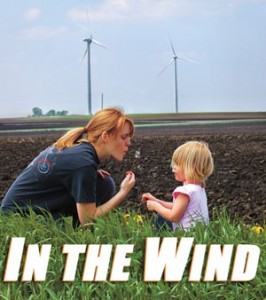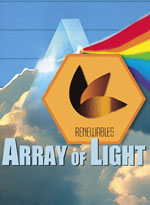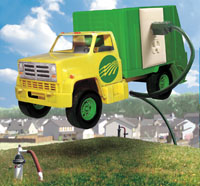Electric cooperatives share in nation’s quest to secure the promise of renewables
Green sprigs of young corn plants signaled spring’s eternal renewal. Their two or three leaves, looking oversized to the yet tiny stalk, waved in the gentle breeze blowing across the open fields of rich brown earth.

Courtney Silk shows the power of the wind to her 3-year-old daughter, Mackenzie, by blowing the seeds of a mature dandelion. Meanwhile, all around their rural northern Benton County home, the power of the wind is being harvested for electricity. The Silks, consumers of Newton County REMC, were out strolling the county roads visiting nearby relatives. Photo by Richard G. Biever
Nearby — and all around to the horizon — gleaming giant towers topped with wind turbines mimicked the tender plants. Their three huge arms slowly swirled as well in the wind with a gentle “whoooosh … whoooosh … whoooosh ….”
Along the roads of northern Benton County, 87 towers rise up from the fields as part of the Benton Wind Farm. Unlike the corn sprouting below them whose time is still to come, the crop of this farm — electricity threshed from the motion of the wind — is already being harvested.
As discussed in the three previous issues of Electric Consumer, huge increases in demand for electricity, a shortage in capacity and concerns over global climate change are threatening the nation’s affordable supply of electricity like never before. One facet of a seven-pronged strategy for our nation to meet demand and cut carbon is increasing the use of renewable and alternative energy sources.
Benton County, site of two large wind projects, sits on a higher plateau than most of Indiana, on the eastern edge of the great prairies that become Illinois. Along with a tiny stretch of Lake Michigan shoreline to the north and another pocket of land northwest of Indianapolis, it’s the best place for wind power in Indiana.
 The Benton Wind Farm, the first of its kind in the state, was developed by Orion Energy, a California-based company that has developed wind generation projects around the globe. When fully operational, Benton’s 87 wind turbines will be capable of generating 130 megawatts — enough to power between 30,000 and 40,000 homes — when the wind blows.
The Benton Wind Farm, the first of its kind in the state, was developed by Orion Energy, a California-based company that has developed wind generation projects around the globe. When fully operational, Benton’s 87 wind turbines will be capable of generating 130 megawatts — enough to power between 30,000 and 40,000 homes — when the wind blows.
Much of the 35-square mile section of land is served by Newton County REMC, and REMC consumers there are leasing small portions of their land for the towers and are drawing income from them. Portions of the Benton Wind Farm started commercial operation in April.
Several miles to the south, construction has started on the Fowler Ridge Wind Farm. This farm will include 222 wind turbines with a 400 megawatt capacity when phase one is completed at the end of this year. A second phase for 2009 will add another 350 megawatts of capacity.
Though the electricity from the two wind farm projects is earmarked for other utilities in the state and elsewhere, Indiana’s consumer-owned electric cooperatives have actively sought and added renewable energy to their power portfolios for almost a decade.
Promoting renewables
Since the 1970s, the nation’s electric co-ops have been actively engaged in promoting renewable energy resources like wind, solar, hydropower and biomass (including landfill gas, livestock waste, timber byproducts, and crop residue). Today, nearly 90 percent of the nation’s 900-plus electric co-ops provide electricity produced by renewable sources, all playing a key role in powering rural America while increasing our nation’s energy independence.
 “Renewable energy makes up approximately 11 percent of all co-op kilowatt-hour use (10 percent hydro and 1 percent non-hydro), as compared to 9 percent for the nation’s entire electric utility sector,” said Kirk Johnson, vice president of environmental policy at the National Rural Electric Cooperative Association, the Arlington, Va.-based service arm of the nation’s consumer-owned, not-for-profit electric cooperatives.
“Renewable energy makes up approximately 11 percent of all co-op kilowatt-hour use (10 percent hydro and 1 percent non-hydro), as compared to 9 percent for the nation’s entire electric utility sector,” said Kirk Johnson, vice president of environmental policy at the National Rural Electric Cooperative Association, the Arlington, Va.-based service arm of the nation’s consumer-owned, not-for-profit electric cooperatives.
The Electric Power Research Institute, a non-profit, utility-sponsored organization whose members include electric co-ops, released a study in 2007 outlining a seven-step plan for how U.S. electric utilities could reduce carbon dioxide emissions to 1990 levels by 2030, while still meeting a 40 percent boost in electricity consumption. One of these measures includes increasing non-hydro renewable energy sources, primarily wind and solar, from 24,000 megawatts to 94,000 megawatts by 2030.
So, what needs to be done to enable a far greater use of renewable energy?
Currently, 150 electric co-ops either own wind turbines or buy output from wind farms, most of which are located in America’s “wind tunnels” — the Upper Midwest, Great Plains, and down the spine of the Alleghenies.
This includes Wabash Valley Power Association, the power supplier to REMCs in the northern half of Indiana. Wabash Valley receives approximately 8 megawatts of wind-generated electricity through an agreement with AgriWind LLC, an Illinois-based developer of wind energy. The electricity is generated by four wind-driven turbines in east-central Illinois. Wabash Valley also has agreed to purchase the output from three future AgriWind projects that will have a combined capacity of 56 megawatts.
Hoosier Energy REC, the power supplier to electric cooperatives in the southern half of Indiana, is also looking at a variety of renewable energy options including wind projects in Indiana, Iowa and elsewhere.
Wind and solar power, however, face challenges: transmission; intermittency and the need for advancements in storage technology; and increased construction costs and delays.
To ensure reliability, baseload plants and quick-starting natural gas plants have to be built in conjunction with wind farms to match and back up wind turbine capacity when the wind doesn’t blow. Even in the gustiest of areas like the Great Plains, wind capacity is being reached only around 40 percent of the time. In Indiana, wind power generation reaches capacity on average only 20 to 30 percent of the time.
 Overcoming these challenges is not impossible but will require strong leadership and investment from government. Here’s how:
Overcoming these challenges is not impossible but will require strong leadership and investment from government. Here’s how:
• Transmission — Renewable resources are abundant in rural areas, but that also means they are located far from the concentrated power needs of cities and towns. To move electric generation from renewable sources (i.e., wind farms), new transmission lines will need to be built to enable greater availability of renewable power sources.
• Intermittency — Most renewable sources are intermittent: the sun doesn’t always shine, and the wind doesn’t always blow. Improved storage system technology would make it possible to store electricity produced by a wind turbine or solar system. When a storm cloud rolls up, stored solar power could be ready and waiting. Electric co-ops are studying ways to boost storage technology, although major breakthroughs have yet to be made.
• Increased Costs/Delays — Construction costs for power plants of all types are rising, and renewable sources are no exception. Three years ago it was estimated that a wind farm would cost about $1,000 per kw of capacity to build. Today that estimate has doubled. In addition to increased costs, the skyrocketing demand for wind turbines has led to a manufacturing backlog of two years or more. For solar panels, costs for installation and operation can run five times higher than a traditional coal plant of comparable size.
Generating electricity from waste
Both Wabash Valley and Hoosier Energy have tapped into the waste gas created at landfills to generate electricity.
The gas is naturally created at landfills as buried organic debris decays. It’s collected in wells drilled into the landfill and piped to the surface. Traditionally, it was flared off.
Landfill gas is mostly methane and is 23 times more potent than carbon dioxide as a greenhouse gas associated with global climate change. So capturing the gas and converting it to electricity reduces the impact on the environment and puts the gas to good use.
Wabash Valley Power first tapped into landfill gas to generate electricity in 2000. Today, through continued cooperation with Waste Management which operates the landfills, Wabash Valley Power’s 10 plants at seven landfill sites in northern and central Indiana produce over 29 megawatts. Wabash Valley Power says that’s enough electricity to power around 21,000 typical homes. A third plant is expected to join two already operating at the landfill in Danville by next year.
Hoosier Energy began generating electricity from its first landfill project in October 2007. The plant at the Clark-Floyd Landfill in Clark County produces 2 megawatts.
Besides putting the waste gas to use, the other good thing about landfill gas projects is the electricity can be generated 24/7. That makes it more reliable — like traditional coal, gas or nuclear generation — and less like other intermittent renewables such as wind and solar.
Wabash Valley Power is also working with large agribusiness operations — such as the large dairy farms in Jasper and Newton counties — to install anaerobic digesters to capture methane gas from animal waste. That gas is then subsequently burned to generate electricity as well.
By separating the methane from the organic waste, the process reduces the noxious gases and pathogens that would normally be released into the atmosphere. Digesters also help make the operations better rural neighbors. Digesters break down the solid and liquid wastes into more benign byproducts which reduces odors and the attraction of flies to the area. Digesters can also mitigate other traditional concerns such as spills and groundwater contamination.
Hoosier Energy’s renewable energy initiatives include solar panel and wind turbine pilot projects planned for five Indiana sites this year. Hoosier Energy also is assessing additional cost-effective renewable energy projects including coal bed methane, animal waste, wood waste, solar and wind technologies.
Co-ops committed to energy solutions
To help electric cooperatives further tap into renewable opportunities, the National Renewables Cooperative Organization was formed in February. Both Hoosier Energy and Wabash Valley Power are charter members of the organization. Operations are anticipated to begin this summer.
“Electric co-ops remain committed to an overall goal of fostering domestic energy independence while benefiting the environment and assisting rural economic growth,” concluded NRECA CEO Glenn English. “While no single approach or policy is appropriate for every co-op, we see renewable generation as an important part of our future. It will not be easy, but it is needed.”
Electric cooperatives are also asking Congress to seek out balanced solutions to energy and climate change. NRECA has introduced a public campaign, “Our Energy, Our Future: A Dialogue With America,” to ensure that the voice of cooperatives and their consumer-members is heard as debates over energy and climate change legislation rage in state legislatures and Congress.
Story by Jennifer Taylor, a consumer and cooperative affairs writer for the National Rural Electric Cooperative Association, and Richard G. Biever, senior editor of Electric Consumer.
Equations to renewable energy

Wind = power
Wind has been used to move ships, grind grain and pump water. To create electricity:
- Wind turbines work opposite of a fan. Instead of using electricity to turn blades to create wind, wind turns the blades which spin a shaft connected to an electric generator to create an electric current.
- Wind turbines come in a variety of sizes and power ratings:
- Large turbines have propellers spanning more than the length of a football field and stand 20 stories high. When the wind is blowing and they’re generating at capacity, they can produce enough electricity to power 700 homes.
- Home-sized turbines have blades between 8 and 25 feet, and stand upward of 40 feet and can partially or fully meet a single home’s energy needs.

Sun = power
Electricity can be generated from sunlight. There are two approaches:
- Photovoltaic technology uses the sun’s light to create chemical reactions. Photovoltaic modules are made up of thin layers of film made of silicone and other conductive materials. When sunlight hits the film, chemical reactions cause the release of electrons which in turn generate electric current.
- Solar-thermal technology uses the sun’s heat and is a more traditional form of electricity generation. Large reflectors (mirrors) are used to concentrate and capture the sun’s heat. The heat is then used to boil water to create steam which runs an electric generator.

Trash = power
The methane gas that builds up under landfills can be used to create electricity. Landfill gas is created when organic material decomposes. To create electricity:
- The gas is collected by drilling wells into the landfill. The methane is then piped to fuel on-site engines/generators creating around 800 kilowatts a piece. A typical 4-engine plant will produce around 3.2 megawatts, enough electricity for around 2,100 homes.
- By capturing the methane and converting it into electricity, methane emissions — a global climate change agent about 23 times more potent than carbon dioxide — is reduced.
- Indiana’s electric cooperatives have installed 11 plants (10 in northern and central Indiana and one in southern) around the state.

Cows = power
Animal waste can be converted to renewable electricity. Here’s how, brown cow:
- Through a process called anaerobic digestion, biogas (a mix of methane and other gases) is generated from cow manure.
- An average 3,500-cow dairy can generate enough electricity to power 750 homes. Two large dairy farms in Jasper County use anaerobic digesters to treat manure and generate electricity for their own operations.
- Anaerobic digesters also reduce greenhouse gas emissions through the capture and use of biogas. Like the landfill plants, burning the gas to power an electric generator trades the more potent methane for carbon dioxide. Digesters also remove offensive odors making the farms better neighbors.



